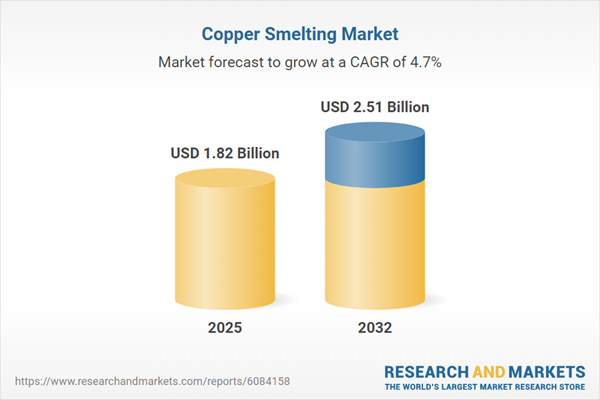Speak directly to the analyst to clarify any post sales queries you may have.
The copper smelting market is evolving to meet modern industrial requirements, integrating advanced technologies and sustainability practices in response to sector shifts. Decision-makers will gain targeted insights for strategic advancement within this dynamic environment.
Market Snapshot: Dynamics of the Copper Smelting Market
The copper smelting market expanded from USD 1.74 billion in 2024 to USD 1.82 billion in 2025, demonstrating consistent growth and sector resilience. The industry is projected to progress at a CAGR of 4.71%, achieving USD 2.51 billion in 2032. Market advancement is guided by continued demand from major industries such as construction, energy, and electronics. Increased emphasis on efficient, cost-effective, and sustainable smelting methods reflects pronounced changes in end-user expectations and regulatory requirements globally.
Scope & Segmentation of the Copper Smelting Market
This report provides a holistic overview of the copper smelting market, dissecting the sector through detailed segmentation and emphasizing innovation and supply chain evolution.
- Source: Both primary and secondary copper smelting processes are assessed, with secondary smelting highlighting the growing use of electric arc furnace technology to support sustainable operations.
- Process: Various smelting approaches are examined, covering electric smelting methods such as induction furnace and resistance furnace, flash smelting, and reverberatory smelting to illustrate technology adoption and process optimization.
- Product: Outputs including copper cathodes, copper rods, and copper wire bars are detailed to show broad integration into construction, electronics, and infrastructure sectors.
- End Use: Construction (commercial, infrastructure, and residential applications), electrical and electronics (consumer electronics, power generation, telecom, and IT), industrial machinery (such as manufacturing, mining, oil and gas equipment), and transportation (encompassing aerospace, automotive, marine, and railway industries) all form significant end-user segments.
- Region: Coverage includes the Americas (North and Latin America), Europe, Middle East & Africa (with detailed review of individual regions), and Asia-Pacific (featuring China, India, Japan, and Southeast Asian countries), reflecting global demand patterns and regional supply strategies.
- Industry Participants: In-depth analysis of prominent corporations such as Corporación Nacional del Cobre de Chile, Glencore plc, BHP Group Limited, Freeport-McMoRan Inc., Southern Copper Corporation, KGHM Polska Miedź S.A., Jiangxi Copper Corporation Ltd., Aurubis AG, Hindalco Industries Limited, and Public Joint Stock Company MMC Norilsk Nickel highlights strategic developments and competitive dynamics.
Key Takeaways for Copper Smelting Market Leaders
- Integration of digital process controls and improved furnace technologies is driving enhanced productivity and environmental compliance across operations.
- Transition toward decarbonization is fueling increased use of secondary smelting, with circular economy models supporting profitability and regulatory alignment for smelters and downstream partners.
- Supply chain frameworks are adapting to changing geopolitical forces and shifting regulations, requiring more robust sourcing solutions and refined logistical coordination for reliable material flow.
- Market variance exists across geographies: the Americas benefit from infrastructure incentives, Europe prioritizes low-emission mandates, and Asia-Pacific leads in energy-efficient technological deployment.
- Partnerships and joint ventures among smelters, recyclers, and technology suppliers are fundamental for ongoing innovation and to maintain a strong competitive position.
Copper Smelting Market: Tariff Impact
Recently implemented tariff measures, notably those from the United States in 2025, have altered global trade flows and cost structures within the copper smelting industry. These actions have led firms to re-evaluate production locations and accelerate investments in secondary smelting and recycling. This shift improves resilience in supply chains while aligning with sustainability objectives through increased use of recycled copper and localized processing.
Methodology & Data Sources
Research methodology draws from direct interviews with executives and plant managers, as well as analysis of technical publications, filings, and compliance documentation. Scenario planning models, value chain mapping, and benchmarking support the research, with sector expert peer review ensuring data reliability and accuracy.
Why This Report Matters
- Enables stakeholders to develop informed investment strategies and optimize operations by presenting actionable insights on segmentation, regulatory policies, and technology trends relevant to the copper smelting sector.
- Clarifies the direct effects of policy shifts and trade measures on pricing, sourcing, and strategic business planning for operators and allied companies.
Conclusion
The copper smelting industry presents both challenges and opportunities as it advances. This report equips senior leaders with the intelligence needed to refine strategies, manage shifting regulatory landscapes, and capture technological advancements for future growth.
Table of Contents
3. Executive Summary
4. Market Overview
7. Cumulative Impact of Artificial Intelligence 2025
Companies Mentioned
The companies profiled in this Copper Smelting market report include:- Corporación Nacional del Cobre de Chile
- Glencore PLC
- BHP Group Limited
- Freeport-McMoRan Inc.
- Southern Copper Corporation
- KGHM Polska Miedź S.A.
- Jiangxi Copper Corporation Ltd.
- Aurubis AG
- Hindalco Industries Limited
- Public Joint Stock Company MMC Norilsk Nickel
Table Information
| Report Attribute | Details |
|---|---|
| No. of Pages | 198 |
| Published | November 2025 |
| Forecast Period | 2025 - 2032 |
| Estimated Market Value ( USD | $ 1.82 Billion |
| Forecasted Market Value ( USD | $ 2.51 Billion |
| Compound Annual Growth Rate | 4.7% |
| Regions Covered | Global |
| No. of Companies Mentioned | 11 |









